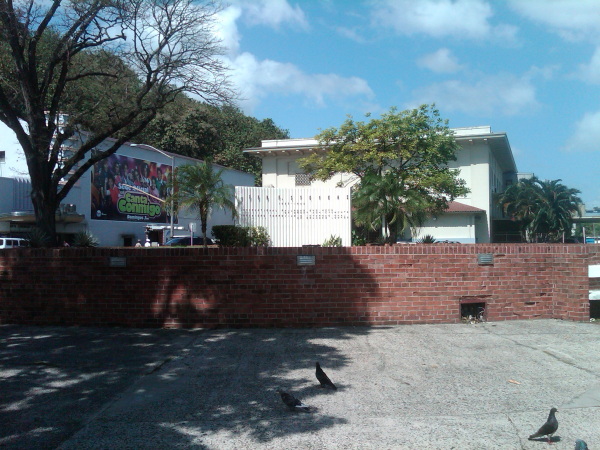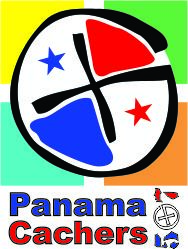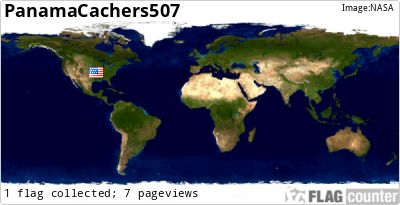
The cache is 35mm film canister with an Official Geocache label.
Original content includes: custom logbook, pencil and bilingual
stash note. There's a GEOCACHING.COM text sticker properly
identified for FTF.
PLEASE RE-HIDE THE CACHE AS WELL OR EVEN BETTER THAT YOU
FOUND IT.
Maybe you want to join this
search with others caches in the area like Goethals Monument by
Panamapilot, "Servidor de
la Nación Panameña", and Old Panama R.R. Station,
Balboa.
About John F. Stevens and His Circle (from The Panama
Canal Review - Sept. 7, 1962):
"Now undergoing a substantial face lifting, the Balboa traffic
circle will soon be the first Canal Zone area named in honor of a
construction era civilian engineer.
Next month, with Undersecretary of the Army Stephen Ailes
scheduled to attend, the circle will officially be named in honor
of John F. Stevens, the tall, broad-shouldered, hard-driving
engineer largely responsible for the basic engineering work that
made the Canal's construction possible.
In addition to Mr. Ailes, who as a boy knew Stevens, members of
Mr. Stevens' family also are expected to attend the dedication.
In the center of Stevens Circle will be a three-sided monument
of white portland cement concrete, with an inscription in Spanish
and English in raised anodized aluminum letters. The mahogany trees
in the park will be retained, but planters will be added. A raised
center section in the park will be walled with brick and will have
benches inserted in half the area. Decorative lighting also will be
installed.
John Frank Stevens was recognized as the world's foremost
railway civil engineer when he arrived on the Isthmus in 1905.
Tall, broad-shouldered, tough, the new Chief Engineer met no
reception formalities. The wharves were crowded with scared, quiet
men waiting to return to the States on the very ship he came
on.
The fundamental problem that he faced was one of restoring
confidence and morale. Health came first. The men needed food
supplies and markets, decent living quarters, relief from the drab
existence in the form of social rooms and entertainment. One of his
first ideas, and a most happy one, was that of the food car.
Stevens found the men were actually hungry, and the men found that
they had a boss who took a personal interest in their welfare. With
the food came some strong talk. Dressed like the men, Chief
Engineer Stevens stood among them, spoke their blunt language,
rubbed their elbows.
"There are only three diseases on the Isthmus," he charged into
them, "yellow fever, malaria, and cold feet. The worst is cold
feet. That's what's ailing you." It was the scolding they needed.
Groups began arguing themselves into staying a little longer. Some
good might come out of the chaos yet.
President Theodore Roosevelt, in a private brief interview, had
confided that "affairs are in a devil of a mess." It was no
understatement. A yellow fever epidemic, followed by the unexpected
resignation of the first Chief Engineer, John F. Wallace, made the
Canal Zone a scene of chaos and hysteria, and threatened the
security of the Canal program, then still in the experimental and
development state.
A small but palatial residence outside Panama City had been
designed by the Canal Commission as a fitting residence for Chief
Engineer Stevens. He brushed these plans aside and requested
instead a cheap bungalow with a corrugated iron roof on the side of
Culebra Cut where he could be near the job. In overalls and slouch
hat he rode the "locals" and the "freights." He was abrupt but
liberal in delegating responsibility, and had a way of bringing out
the best in a man.
"Big Smoke" was Stevens' nickname from the start. When he wasn't
chain-smoking cigars, he was chain-chewing them.
The Canal job had been going on a quarter of a century when he
made his first survey tour. He found no order, no plan on the job.
In fact, no decision had been made as to whether the Canal would be
sea level or lock type.
John F. Stevens was an ardent supporter of Dr. William Gorgas in
his humanitarian battle against yellow fever on the Isthmus, and
the men sized him up as an important man who didn't have to act
important. If anybody was going to build a canal he could.
He planed the main features of the waterway and lobbied openly
in May and June 1906 for a high-level, lock-type canal; swung
President Theodore Roosevelt back into line when he wavered in
favor of sea-level construction; helped Senators draft speeches,
prepared maps, and produced statistics. Calmly he pointed out the
awkward, dangerous, expensive, and slow procedure involved in a
sea-level canal planned at that time. On June 29, 1906, the
President's signature put into law a bill calling for the
high-level, lock-type canal.
Chief Engineer Stevens received the additional appointment as
Chairman of the Isthmian Canal Commission in March 1907, shortly
before his resignation. His original agreement had been to stick to
the job until he could predict success or failure according to his
own judgment. Success was assured. "I fulfilled my promise ... to
the very letter," he maintained. He had rescued the Canal from
chaos and defeat.
The Canal job was assigned on February 18, 1907, to the United
States Army, in the person of Colonel (later General) George
Washington Goethals. In a letter to his son, Colonel Goethals wrote
"Mr. Stevens has perfected such an organization ... that there is
nothing left for us to do but just have the organization continue
in the good work it was done and is doing ... Mr. Stevens has done
an amount of work for which he will never get any credit, or, if he
gets any, will not get enough ..."
Officially, John "Big Smoke" Stevens remained in command until
midnight March 31, 1907, but for more than a week his principal
occupation was accepting tributes. In the few years of U.S. work on
the Canal, the comings and goings of Presidents, Cabinet members,
Senators, and foreign dignitaries, the Zone had witnessed nothing
that equaled the send-off for John F. Stevens on the night of April
17, 1907. Said one historian, "It was as if the people were
honoring a man who had already built the Panama Canal" -- and they
were fully aware it was he who made it possible, for from his
administration dates the really fundamental work of canal building,
the preparation of the ground for the edifice to be erected.
John F. Stevens returned to the United States and railroading.
In 1919 he was named president of the Inter-Allied Technical Board
with headquarters in Harbin, Manchuria. His work completed, he
returned to the United States in 1923 and retired from active
life.
He was presented the John Fritz Gold Medal on March 23, 1925,
for "great achievements as a civil engineer, particularly in
planning and organizing for the construction of the Panama Canal;
as a builder of railroads, and as administration of the Chinese
Eastern and Siberian Railways." The Hoover Gold Medal was given him
in 1938.
He was elected a member of the American society of Civil
Engineers on June 6, 1888, and an honorary member on June 18, 1922.
In 1927 he served as President of the Society.
He died on June 2, 1943, in Southern Pines, N.C. after he
celebrated his 90th birthday."

